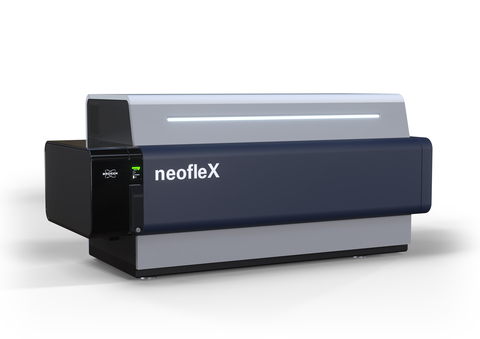Bruker Launches Transformative neofleX™ MALDI-TOF System for Spatial Biology Mass Spec Imaging (MSI) Applications
Bruker announced the release of the neofleX Imaging Profiler MALDI-TOF/TOF system, enhancing mass spectrometry imaging for tissue research. The neofleX, featuring a 10 kHz smartbeam 3D laser, offers high pixel fidelity and robust performance in various modes. It supports multiomics MSI, correlating proteins with glycans, metabolites, and now mRNA/DNA.
At the ASMS 2024 conference, researchers demonstrated the system's capability, mapping 116 proteins in a lung tissue section in 7 hours. The neofleX is compatible with MALDI-ISH and HiPLEX-IHC technologies, enhancing spatial biology research in fields like oncology and neuroscience.
The system's SCiLS Scope software facilitates easy data output and visualization, promoting collaboration in translational research.
- Launch of neofleX Imaging Profiler MALDI-TOF/TOF system enhancing tissue research.
- High-performance with 10 kHz smartbeam 3D laser for pixel fidelity.
- Supports multiomics MSI, correlating proteins with various biomolecules.
- Demonstrated capability to map 116 proteins in a lung tissue section in 7 hours.
- Compatible with advanced spatial biology technologies like MALDI-ISH and HiPLEX-IHC.
- Facilitates visualization and collaboration with SCiLS Scope software.
- No specific financial performance data or revenue projections provided.
- Potential high costs associated with advanced technology and implementation.
- information on commercial availability and pricing details.
Insights
The introduction of the neofleX™ MALDI-TOF/TOF system by Bruker represents a significant advancement in the field of spatial biology and mass spectrometry imaging (MSI). The system's ability to integrate protein tissue imaging with multiomics MSI correlation—covering proteins, glycans, metabolites, lipids, peptides and nucleic acids—offers comprehensive insights into cellular processes and states. For researchers working in diverse fields such as oncology and neuroscience, this multi-modal approach could revolutionize how they visualize and interpret molecular data. The compatibility with MALDI HiPLEX-IHC for immunohistochemistry and MALDI-ISH for in situ hybridization further adds value, providing robust tools for detailed spatial tissue research. By offering high sensitivity and speed in TOF/TOF mode and ease of use, the neofleX addresses several unmet needs in both translational and clinical research.
However, it's important to recognize the potential limitations such as the need for specialized training to maximize the system's capabilities and the costs associated with transitioning to this new technology, which may not be feasible for all research institutions. These factors may affect the adoption rate and broader market penetration in the short term.
From a technical perspective, the neofleX™ system's incorporation of the smartbeam 3D laser for high pixel fidelity and the enhanced imaging detectors, positions it as a top-tier tool for spatial biology imaging. The ability to output in the OME-TIFF format via the new SCiLS Scope software simplifies data sharing and enhances collaboration, which is particularly valuable in multi-center research projects. The integration of these features into a bench-top system is noteworthy, as it aligns with the growing trend towards compact and versatile laboratory equipment that doesn't compromise on performance. This compact form factor could be particularly appealing for labs with limited space but high analytical needs.
However, the dependence on proprietary software and consumables might be a double-edged sword. While it ensures optimized performance, it also locks users into Bruker's ecosystem, potentially increasing long-term costs for consumables and software updates.
Bruker's launch of the neofleX™ MALDI-TOF/TOF system at the 72nd ASMS meeting strategically positions the company in the high-growth spatial biology and mass spectrometry market. The comprehensive feature set of the neofleX—coupled with its ease of use—could drive significant demand from biopharma and clinical research sectors. This product rollout aligns with the increasing trend towards multiomics in drug discovery and personalized medicine, enhancing Bruker's market competitiveness.
However, the success of this product will depend on its adoption by key opinion leaders and prominent research institutions. If Bruker can demonstrate clear and reproducible advantages in high-impact studies, it could quickly capture market share. Investors should keep an eye on the uptake rate and peer-reviewed publications citing the use of neofleX as leading indicators of its market performance.
- neofleX is a versatile, high-performance, and easy-to-use multiomics MSI system for biopharma, translational and clinical researchers
- neofleX Imaging Profiler MALDI-TOF/TOF with proprietary smartbeam 3D laser
- neofleX and MALDI HiPLEX-IHC technology enable protein tissue imaging
- Multiomics MSI correlation of targeted proteins with glycans, metabolites, lipids, endogenous peptides, and now also mid-plex mRNA/DNA-ISH
- More insights per pixel with new SCiLS™ Scope software and OME-TIFF output

neofleX MALDI-TOF System for Spatial Biology Mass Spec Imaging (MSI) Applications (Photo: Business Wire)
The neofleX Imaging Profiler MALDI-TOF/TOF mass spectrometer comes standard with Bruker’s proprietary 10 kHz smartbeam 3D laser for true pixel fidelity and with enhanced imaging detectors designed for longitudinal robustness, stability, and reproducibility in linear and reflector modes. neofleX is also available as a TOF/TOF configuration that features a reimagined fragmentation module for significantly improved TOF/TOF sensitivity, speed and sequence coverage.
Created for the unmet needs of moving from discovery imaging to translational and clinical tissue research, neofleX was used by the group of Prof. Bernd Bodenmiller at ETH and University of
In addition to MALDI HiPLEX-IHC MSI immunohistochemistry, neofleX is also compatible with the MALDI-ISH (in situ hybridization) method announced at ASMS 2024 by AmberGen, Inc. MALDI-ISH multiplexes imaging of up to 12 oligomers of interest (RNA/DNA) for multiomic spatial tissue research in neuroscience, infectious disease, and oncology.
The novel neofleX excels at providing more insight per pixel through multiomic spatial biology data from tissue sections that can positively correlate targeted proteins with glycans, metabolites, lipids, endogenous peptides, xenobiotics, and now RNA/DNA. This additional multiomics context provides important adjacency information about cellular states, function, structure, and protein activity for a range of research areas, such as oncology and neurology.
Professor Carsten Hopf of the University of Mannheim,
Multiomic co-localization of lipids and glycans on a tissue section allows to not only localize protein targets using MALDI HiPLEX-IHC, but also assess protein activity and function. A study performed at CeMOS on brain tissues from a transgenic mouse model demonstrated co-localization of amyloid β-42 (Aβ42) protein with a targeted membrane-bound glycosphingolipid (GM3 d36:1), yielding important structural information.
Dr. Michael L. Easterling, Vice President MSI for Bruker’s Life Sciences Mass Spectrometry division, commented: “The neofleX offers unique combination of outstanding performance, multimodal software and workflows on the benchtop for a wide range of biopharma and clinical researchers. Additionally, neofleX brings novel capabilities to spatial biology, including spatial proteomics combined with unique multiomics correlations for developing actionable biological insights.”
The neofleX is compatible with Bruker’s MALDI Imaging software and consumables ecosystems, such as IntelliSlides™ and SCiLS autopilot that simplify sample tracking, preparation, and analysis and require minimal input from users to initiate and process automated mass-spec imaging runs. For ease of collaborations, the neofleX now delivers targeted imaging data via automatically generated OME-TIFF images that can be viewed within the SCiLS environment, or easily exported into custom pipelines or digital pathology systems.
Bruker also announced extension of the SCiLS portfolio with SCiLS Scope 1.0 for collaboration around targeted, multiomic translational workflows developed for neofleX. SCiLS Scope software supports OME-TIFF datasets from targeted imaging workflows such as MALDI HiPLEX-IHC. Ion images are visualized by false-color coding of selected channels, and image processing and distance measurements can be accomplished with simple tools.
Blaine R. Roberts, Ph.D., Associate Professor in the Department of Biochemistry and Department of Neurology at Emory University in
About Bruker Corporation – the Emerging Leader of the Post-Genomic Era (Nasdaq: BRKR)
Bruker is enabling scientists and engineers to make breakthrough post-genomic discoveries and develop new applications that improve the quality of human life. Bruker’s high-performance scientific instruments and high-value analytical and diagnostic solutions enable scientists to explore life and materials at molecular, cellular, and microscopic levels. In close cooperation with our customers, Bruker is enabling innovation, improved productivity, and customer success in post-genomic life science molecular and cell biology research, in applied and biopharma applications, in microscopy and nanoanalysis, as well as in industrial and cleantech research, and next-gen semiconductor metrology in support of AI. Bruker offers differentiated, high-value life science and diagnostics systems and solutions in preclinical imaging, clinical phenomics research, proteomics and multiomics, spatial and single-cell biology, functional structural and condensate biology, as well as in clinical microbiology and molecular diagnostics. For more information, please visit www.bruker.com.
View source version on businesswire.com: https://www.businesswire.com/news/home/20240603327426/en/
Media
Petra Scheffer
Bruker Daltonics Marketing Communications
T: +49 (421) 2205-2843
E: Petra.Scheffer@bruker.com
Investor Relations
Justin Ward
Sr. Director Investor Relations & Corp Development
T: +1 (978) 313-5800
E: Investor.Relations@bruker.com
Source: Bruker Corporation







